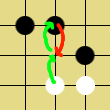
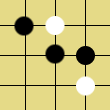
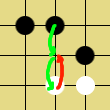
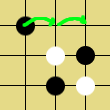
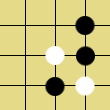
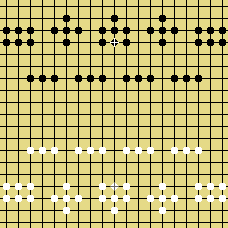 Each player begins with 41 pieces of one color placed on a 19 x 19 (go) board as shown. One of the pieces for each player (marked by diamonds below) is that player's king. (I use small black and clear Icehouse pieces for the kings, and go stones for the rest, but in these rules I use "stone" to mean any piece.)
Each player begins with 41 pieces of one color placed on a 19 x 19 (go) board as shown. One of the pieces for each player (marked by diamonds below) is that player's king. (I use small black and clear Icehouse pieces for the kings, and go stones for the rest, but in these rules I use "stone" to mean any piece.)
A Group is a set of stones that are vertically and horizontally connected. The size of the group a stone is in determines how it can move, and whether it can capture or be captured. In these rules, it is the size of the group a stone is in at the beginning of the turn that is relevant, even if during a turn the nature of the groups change.
A normal move consists of moving a stone of one's color that one has not already moved this turn in a sequence of horizontal or vertical single steps. The steps need not be all in the same direction. The maximum number of steps a stone can move is equal to the size that the group it was in had at the beginning of the turn minus one. (It may move fewer than the maximum number of steps.) Therefore a single stone with no other stones in its group is stranded; it cannot move at all. If you move into a cell with an opponent's stone, that stone is captured. A captured stone is not removed from the board, but is swapped into the position the capturer moved from in its last step. After a capture is made, the move ends, and the capturing piece may not move again that turn. It is not legal to capture a stone in a group that is smaller than the group the capturing stone came from. (Remember, it is the size of the groups these stones were in at the beginning of the turn that matters.) It is also not legal to capture one's own stones.
If the previous move in a turn was a normal move, did not include a capture, and was not made with a king, an echo move may follow it. In an echo move, the piece that moved in the last move repeats the sequence of steps it made in that move. It will stop before the end of that sequence if it makes a capture, or if the next step in the sequence would be onto a stone that it cannot capture, or off the edge of the board.
It is possible for positions to occur where a capture does not increase the quantity of the opponent's groups. For example, in the diagram below (a and b,) white can capture the stone in the top center position, but that stone then joins another black group. (Notice that the other white stone cannot then capture the black stone on the right, because that stone started the turn in a group of size 1, and the white stone was initially in a group of size 2.) C, d, and e show how black can capture and reconsolidate from the same position.
 |
 |
 |
 |
 |
a | b | c | d | e |
There is also a tension in the size of groups one should keep. Larger groups offer mobility but little capturing power, and are themselves vulnerable to capture; they tend to be most useful deep in one's own territory. Smaller groups are potent at capturing, but relatively immobile, and are best near, (or behind,) enemy lines.
I've noticed in playtesting that keeping track of the number of groups and the size of groups stones came from is a little annoying, (although by no means impossible.) It would definitely be nice to let a computer keep track of all that.